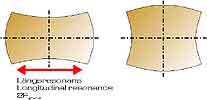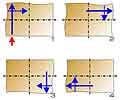Investigations on Resonant Phenomena in Jelly
1.0 Introduction
A large piece of food jelly, having a weight of some 15 kilograms, consisting of 93% water, with some admixture
of fish and citric acid, and top garnishing of cream, was investigated. The piece of jelly had the shape of a fish
tank, and is thus below called “jelly fish tank”. During initial investigations, parts of the garnishing fell off.
It may therefore be said not to have affected the measurements made in the following.
2.0 Basic Resonance Modes
 The basic resonance frequencies of the jelly were
investigated. The resonance frequencies of the longitudinal, transversal and axial modes were excited using a finger.
Some 50 fluctuations were registered whereupon the resonance frequencies were calculated.
The basic resonance frequencies of the jelly were
investigated. The resonance frequencies of the longitudinal, transversal and axial modes were excited using a finger.
Some 50 fluctuations were registered whereupon the resonance frequencies were calculated.
The following resonance frequencies were calculated:
Longitudinal Resonance Frequency: 1.93 Hz
Transverse Resonance Frequency: 1.80 Hz
Axial Resonance Frequency: 2.23 Hz
Further resonance modes were measured, below called Corner Resonances. When the jelly was excited at some corner,
a simultaneous longitudinal and transversal standing wave occurred, yielding a resultant oscillation from corner
to corner, having a frequency, quite as was expected, near the transversal and longitudinal resonance frequencies.
2.1 Second Order Resonances
 Now, the jelly fish tank was excited at twice
the basic resonance frequency longitudinally, yielding a standing wave that made the jelly body exhibit longitudinal
density waves, with bellies and nodes along the sides. The amplitudes at times reached such values that the rest
of the garnishing flew off.
Now, the jelly fish tank was excited at twice
the basic resonance frequency longitudinally, yielding a standing wave that made the jelly body exhibit longitudinal
density waves, with bellies and nodes along the sides. The amplitudes at times reached such values that the rest
of the garnishing flew off.
2.2 Internal Reflections of Shock Waves
 To observe how shock waves travelled through
the jelly, it was subjected to a shock, a transient having an amplitude of about 10 mm, with partial frequencies
far above the resonance frequency. Thus, a shock wave travelled through the medium until it met with a border (the
jelly-air interface) which had a refractional index of such magnitude that a reflection occurred.
To observe how shock waves travelled through
the jelly, it was subjected to a shock, a transient having an amplitude of about 10 mm, with partial frequencies
far above the resonance frequency. Thus, a shock wave travelled through the medium until it met with a border (the
jelly-air interface) which had a refractional index of such magnitude that a reflection occurred.
The oncoming shock wave was of the density type, making the material bulge outward in the border region where
the reflection occurred. This resulted in a dilution of material in the neighbouring areas, causing the surface
at 90 degrees from previous to curve inwards. As a result of this, a new shock wave started travelling at a 90
degree angle to the previous one, propagating towards the next interface.
At the next interface the procedure repeated, and a new shock wave was created, 90 degrees from the previous
one. As the shock wave had travelled some 8 reflections it was completely attenuated, its energy converted into
other shock waves with random directions (wobbling in general). The material had at this stage suffered a large
amount of internal ruptures, serving as more or less effective shock wave reflectors.
2.3 Destructive Testing
Finally, the jelly was investigated regarding its stress limits and maximum amplitudes. The test was conducted
in a protected environment (kitchen sink).
As the jelly fish tank was subjected to a longitudinal resonant vibration with a 200 mm peak-peak amplitude
for 15 seconds, the structure collapsed in a number of smaller fragments. The fractured surfaces showed structures
much like the ones in glass: plane, parallel surfaces, fan-shaped ruptures etc., which points to the material having
an amorphous structure.
3. Waste Disposal
The waste products remaining from the experiments are planned to be disposed of partly by ingestion of the device
under test, partly by just letting time pass...
Appendix: Specifications
|
Specification
|
Value
|
|
Device Under Test
|
Block of jelly, with admixation of jelly fish of stiffer type
|
|
Dimensions
|
300 x 200 x 250 mm (WxHxD)
|
|
Weight
|
15 kg +/- 0.1 kg
|
|
Colour, jelly
|
Golden brown to light rust colour
|
|
Colour, fish
|
Red, yellow and green
|
|
Constitution
|
Atamon food jelly, or equivalent, prepared according to the manufacturer's instructions
|

 The basic resonance frequencies of the jelly were
investigated. The resonance frequencies of the longitudinal, transversal and axial modes were excited using a finger.
Some 50 fluctuations were registered whereupon the resonance frequencies were calculated.
The basic resonance frequencies of the jelly were
investigated. The resonance frequencies of the longitudinal, transversal and axial modes were excited using a finger.
Some 50 fluctuations were registered whereupon the resonance frequencies were calculated.

